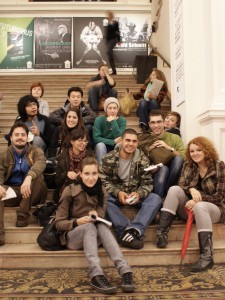
In spite of the fact that it was first developed ninety years ago, and that the art school only existed for fourteen years, Bauhaus never gets old. There is always something new to discuss about one of the greatest schools of modernity. As part of the Berlin Weekend program, on Friday October 2, a group of students from the European College of Liberal Arts visited the Martin Gropius Bau on the occasion of the exhibition “Bauhaus. A Conceptual Model.”
The exhibition was laid out in eighteen different galleries, organized in chronological order, each one of them representing a different period in the history of the Walter Gropius School of Design and Architecture. The first stage of the tour frames the birth of Bauhaus, giving information on the social situation that obtained in the early 1900s. At the end of this stage there was a video of Gropius himself explaining how he changed his conception of art in order to respond to the social changes occurring at that time.
Unlike other exhibitions on Bauhaus, which have tended to focus on one particular period of the school, this one was structured in order to provide a clear view of the engagement with modernity that the school undertook. The exhibition proceeds all the way through galleries such as “Bauhaus. A conceptual Model”, “The Bauhaus Masters”, “The Student’s Free Art”, “Elementary and Constructive”, “The teaching of Kandinsky, Klee and Moholly-Nagy”, to “De Stijl and Constructivism” and “The 1923 Exhibition”, to name just a few. The visitors could then see the most important issues that the architecture school dealt with. As stated by the organizers: “The exhibition Bauhaus. A Conceptual Model centers on the comprehensive significance of the Bauhaus for the development and internationalization of modernity and goes beyond, examining its world-wide, lasting impact on architecture and design up until the present day”. The relevance of the exhibition extends well beyond the Bauhaus movement itself, displaying the enduring influence of Bauhaus throughout subsequent decades.
Bauhaus is commonly known for its workshops, the art-studio class format, and also for its concise and practical view of design. But the exhibition didn’t only show the most popular aspects of Bauhaus. The last galleries were dedicated to lesser known themes such as “The Organization of Life Processes”; “People’s Necessities, not Luxuries”; “Photography at the Bauhaus” and “Intentional Time Captured in Space”.
While all these galleries were around the hall, the center bore two very intriguing pieces. One of them was the Installation “Do-it-yourself-Bauhaus”, by the American artist Christine Hill, which focused on the trivialization of Bauhaus in today’s consumer and every-day culture. The other piece was a video installation by Ilka and Andreas Ruby, “Endless Bauhaus”, where ten interviewees expressed their opinion about the meaning of Bauhaus ideas today.
Designed by the scenographers Chezweitz & Roseapple, “Bauhaus. A conceptual model” was presented in collaboration with the Museum of Modern Art in New York. This exhibition, with well over 900 pieces, constitutes the largest Bauhaus exhibition in history. From the viewpoint of a liberal arts student, it was very enriching to appreciate – in an holistic way – this major contribution to the history of art and design.
By María Cruz (AY ’10, Argentina)
